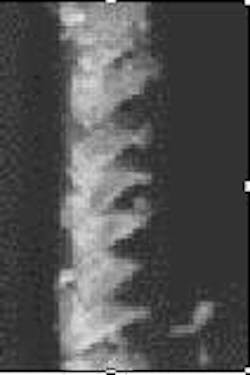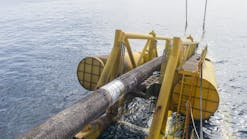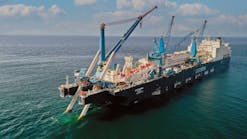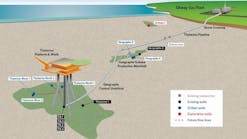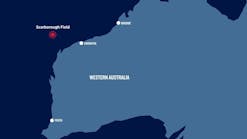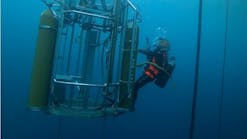By Jonathan Southgate, Pipeline Engineering and Supply Company
Deposition of paraffin solids in pipelines represents a continuing challenge to flow-assurance, particularly offshore, where low temperatures exacerbate wax precipitation. Wax deposits cause exponential reductions in throughput if they are not dealt with or prevented. For example, if wax just 3 mm thick is deposited in a 100-mm flowline, the reduction in throughput will be on the order of 15%. The increase in pressure required to restore throughput will be over 36%. Depending on the type of oil and location of the line, this thickness of wax may develop over months or days.
Wax chip showing brittle fracture.
While prevention of wax deposition is preferable from the outset, it is not always practical. Wax inhibitors vary in their effectiveness. Pipe-in-pipe systems may not be economically viable where production is marginal. Pigging is one of the more effective and economical approaches to wax removal. Provided a suitable means for launching and receiving the pig is available and a suitable schedule is followed, flow assurance can be maintained at a high standard.
Pig performance
Given the importance of this technology to the oil industry, pigging for production purposes remains surprisingly unscientific. A cleaning pig can employ a variety of tools, such as scraper discs, ploughs, and brushes, but their effect on wax deposits is often poorly understood. In response, Pipeline Engineering, based in Richmond, northern England, is sponsoring research into wax removal to improve understanding of the physical mechanisms by which wax is removed from the pipe wall.
In light of the wide-ranging parameters involved in the pigging process, a robust experimental model has been devised that considers the interaction of variables, such as tool type, pig velocity, wax thickness, and consistency. A test rig is currently being constructed at the engineering laboratories of nearby Durham University. This will allow experimentation to proceed over the coming year. The research at Durham differs from previous work in this area as it will concentrate not purely on quantifying reactive forces measured at the tool due to the pressure differential across the pig, but will attempt to fully describe failure mechanisms within the wax under various conditions.
Two kinds of wax
The experimental work has generated samples of paraffin wax. A chip removed from a sample of hard paraffin wax is comparable with the sort of chip encountered in metal turning operations. This is not surprising as paraffin wax has been used as a physical model for various metal processing operations. This type of metal cutting chip is often referred to as "discontinuous," although its constituent segments are fused together under most conditions. However, its wax counterpart will only too readily disintegrate into its individual segment parts.
Contrast this with another sample of the same material removed under a different set of conditions, and the wax fails by a different mechanism. In this case, brittle fracture of the wax is the predominant mode of failure, as opposed to the shearing that occurs in the production of discontinuous chips. Not only is there a different energy requirement for these two failure mechanisms, but the chip segment size also differs considerably, and in a predictable manner. With the ability to predict the nature of the wax chip that will be produced under any given set of circumstances, the operator is able to exercise a previously unobtainable degree of control over the pigging process.
A major constraint when pigging is that of downstream plugging due to removed deposits, i.e., the pig catching up with the wax it has removed. A second phase of research at Durham will enhance process control by correlating predicted chip types with their suspension forming ability. This will allow pig designers to create pigs that will produce wax chips of the optimum geometry for transport downstream as a suspension within the crude. Other benefits might be the matching of filtration and process equipment to these predicted particle sizes.
Reducing pressure across the pig
An equally important aspect of the research is the identification of optimum tool geometry for removing wax using a minimum force. This will allow a reduction in the required pressure differential across pigs and broaden the scope for using bypass to ensure the suspension of removed solids. Reduced forces at the tool face will also mean less wear, and designers can, at all development stages, make a clearer differentiation between the wax removal and drive functions of the pig.
Moving forward
At present, the performance of cleaning pigs is notoriously difficult to evaluate. The quantity of wax removed can be measured as the sum of that retrieved from the filters, pig, and trap. However, this information is quite meaningless if the amount of wax in the pipe prior to pigging is not known. Software has been developed to predict wax deposition in a given section of pipe, but to prove the software's accuracy in the field would require the assumption that the removed wax represents all of the wax deposited in the line. This situation is clear evidence of a need for greater accuracy in predicting the effectiveness of cleaning pigs.
If we have to place faith in a pig doing what it is supposed to, then we should at least know what the pig is supposed to be doing. Each pipeline requires a unique solution to improve its flow. Off-the-shelf pigs may be a partial solution, but without a thorough investigation of the pipeline and a specific pigging regime designed for that line, an optimum result will not be achieved.
Author
Jonathan Southgate is a research engineer working at Durham University on behalf of Pipeline Engineering. E-mail: [email protected].
